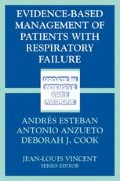Access this chapter
Tax calculation will be finalised at checkout
Purchases are for personal use only
Preview
Unable to display preview. Download preview PDF.
References
Echt DS, Liebson PR, Mitchell LB, et al (1991) Mortality and morbidity in patients receiving encainide, flecainide or placebo: the Cardiac Arrhythmia Suppression Trail. N Engl J Med 324:781–788
Eichacker PQ, Parent C, Kalil A, et al (2002) Risk and the efficacy of antiinflammatory agents. Retrospective and confirmatory studies of sepsis. Am J Respir Crit Care Med 166:1197–1205
Bickell WH, Wall MJ Jr, Pepe PE, et al (1994) Immediate versus delayed fluid resuscitation for hypotensive patients with penetrating torso injuries. N Engl J Med 331:1105–1109
Dellinger RP, Zimmerman JL, Taylor RW, et al (1998) Effects of inhaled nitric oxide in patients with acute respiratory distress syndrome: Results of a randomized phase II trial. Crit Care Med 26:15–23
Michael JR, Barton RG, Saffle JR, Mone M, et al (1998) Inhaled nitric oxide versus conventional therapy. Effect on oxygenation in ARDS. Am J Respir Crit Care Med 157:1372–1380
Lundin S, Mang H, Smithies M, Stenqvist O, Frostell C, for the European Study Group of Inhaled Nitric Oxide (1999) Intensive Care Med 25:911–919
Troncy E, Collet JP, Shapiro S, Guimond JG, et al (1998) Inhaled nitric oxide in acute respiratory distress syndrome. A pilot randomized controlled study. Am J Respir Crit Care Med 157:1483–1488
Payen D, Vallet B, and the Groupe dEtude du NO dans lARDS (1999) Results of the French prospective multicentre randomized double-blind placebo-controlled trial in inhaled nitric oxide (NO) in ARDS. Intensive Care Med 25:A645 (abst)
Wood KA, Linde-Zwirble WT, Clermont G, et al (2002) The effect of inhaled nitric oxide on the hospital costs of acute respiratory distress syndrome (ARDS). Am J Respir Crit Care Med 165:A220 (abst)
The Acute Respiratory Distress Syndrome Network (2000) Ventilation with lower tidal volumes as compared with traditional tidal volumes for acute lung injury and the acute respiratory distress syndrome. N Engl J Med 342:1301–1308
Brower RG, Shanholtz CB, Fessler HE, et al (1999) Prospective, randomized controlled clinical trial comparing traditional versus reduced tidal volume ventilation in acute respiratory distress syndrome patients. Crit Care Med 27:1492–1498
Stewart TE, Meade MO, Cook DJ, et al (1998) Evaluation of a ventilation strategy to prevent barotrauma in patients at high risk for acute respiratory distress syndrome. N Engl J Med 338:355–361
Brochard L, Roudot-Thoraval F, Roupie E, et al (1998) Tidal volume reduction for prevention of ventilator-induced lung injury in acute respiratory distress syndrome. The Multicenter Trail Group on Tidal Volume reduction in ARDS. Am J Respir Crit Care Med 158:1831–1838
Amato MB, Barbas CS, Medeiros DM, et al (1998) Effect of a protective ventilation strategy on mortality in the acute respiratory distress syndrome. N Engl J Med 338:347–54
Sun B, Lu Y, Zhou X, Song Z, et al (2002) A survey of adult respiratory distress syndrome in Shanghai hospitals. Am J Respir Crit Care Med 165:A218 (abst)
Rubenfeld GD, Caldwell E, Hudson L (2001) Publication of study results does not increase use of lung protective ventilation in patients with acute lung injury. Am J Respir Crit Care Med 163:A295 (abst)
Froese AB (1997) High frequency oscillatory ventilation for adult respiratory distress syndrome: lets get it right this time! Crit Care Med 25:906–908
Editor information
Editors and Affiliations
Rights and permissions
Copyright information
© 2005 Springer-Verlag Berlin Heidelberg
About this chapter
Cite this chapter
Meade, M.O., Adhikari, N., Burns, K.E. (2005). Lung-Protective Ventilation Trial: A Comparison of Physiologic Effects and Patient-important Outcomes. In: Esteban, A., Cook, D.J., Anzueto, A. (eds) Evidence-Based Management of Patients with Respiratory Failure. Update in Intensive Care Medicine. Springer, Berlin, Heidelberg. https://doi.org/10.1007/3-540-27314-X_10
Download citation
DOI: https://doi.org/10.1007/3-540-27314-X_10
Publisher Name: Springer, Berlin, Heidelberg
Print ISBN: 978-3-540-20947-8
Online ISBN: 978-3-540-27314-1
eBook Packages: Springer Book Archive

